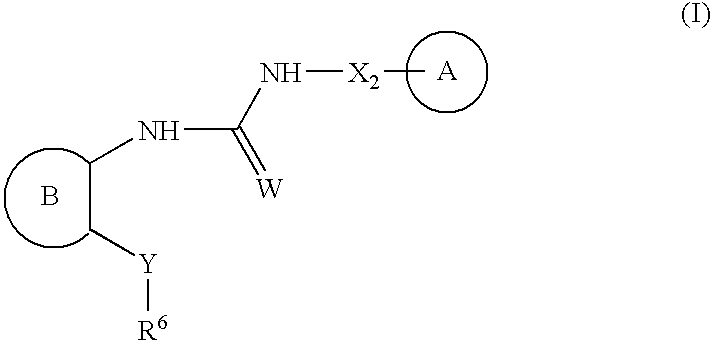Urea antagonists of P2Y1 receptor useful in the treatment of thrombotic conditions
a urea antagonist and p2ysub>1 technology, applied in the field of pyridyl or phenyl ureas, can solve the problems of in vivo study without the necessary pharmacological properties of the antagonis
- Summary
- Abstract
- Description
- Claims
- Application Information
AI Technical Summary
Benefits of technology
Problems solved by technology
Method used
Image
Examples
example 1
1-(4-tert-Butylphenyl)-3-(2-(3-isopropylphenoxy)pyridin-3-yl)urea
[0633]1a. 2-(3-Isopropylphenoxy)-3-nitropyridine: To a solution of meta-isopropylphenol (214 mg, 1.57 mmol) in dry DMF (3 mL) was added cesium carbonate (587 mg, 1.8 mmol) followed by 2-chloro-3-nitropyridine (237 mg, 1.5 mmol). The mixture was heated at 180° C. for 700 s in a Personal Chemistry microwave. The mixture was diluted with water (3 mL) and extracted with ethyl acetate (2×4 mL). The combined organic layers were washed with 5% aqueous LiCl solution (2×1.5 mL), saturated Na2CO3 (2×1.5 mL), water (1×1.5 mL), and then dried over Na2SO4. The solvent was removed in vacuo to yield 1a (338 mg, 87% yield) as a dark brown oil; HPLC purity: 90%, 2.89 min (Method B).
[0634]1b. 2-(3-Isopropylphenoxy)pyridin-3-amine: 1a (338 mg, 1.3 mmol) was dissolved in 1:1 methanol / ethyl acetate (5 mL) and a small spatula of 10% Pd / C was added. The mixture was hydrogenated at 40 Psi for 3.5 h. The catalyst was removed by filtering throu...
example 2
1-(2-(2-tert-Butylphenoxy)pyridin-3-yl)-3-(4-(trifluoromethoxy)phenyl)urea
[0636]2a. 2-(2-tert-Butylphenoxy)-3-nitropyridine: A solution of 2-chloro-3-nitropyridine (21.1 g, 133 mmol) in DMF (100 mL) was treated with 2-tert-butylphenol (23.5 mL, 153 mmol) and cesium carbonate (130 g, 398 mmol). The mixture was heated at 80° C. for 30 h. The reaction was cooled to rt and the mixture was poured into water (1 L) with stirring. The resulting yellow precipitate was filtered, washed with water, and recrystallized from ethanol to afford 2a (32.8 g, 90% yield) as beige crystals; HPLC purity: 92%, 3.66 min (Method A); 1H NMR (400 MHz, CD3OD) δ ppm 1.34 (s, 9 H), 6.93 (m, 1 H), 7.22 (m, 3 H), 7.47 (m, 1 H), 8.31 (dd, J=4.82, 1.75 Hz, 1 H), 8.46 (dd, J=7.89, 1.75 Hz, 1 H).
[0637]2b. 2-(2-tert-Butylphenoxy)pyridin-3-ylamine: 2a (7.2 g, 27 mmol) was dissolved in a 1:1 mixture of methanol and ethyl acetate (160 mL). Palladium on charcoal (10%, 360 mg, 0.33 mmol) was added and the mixture was stirre...
example 3
12-(2-tert-Butylphenoxy)pyridin-3-yl)-3-(4-cyclohexylphenyl)urea
[0639]3a. 22-tert-Butylphenoxy)-3-isocyanatopyridine: To a solution of 2b (7 g, 29 mmol) and diphosgene (4.7 g, 24 mmol) in CH2Cl2 (200 mL) at 0° C. was added dropwise a solution of 1,8-bis[dimethylamino]naphthalene (proton sponge, 12.6 g, 57 mmol) in CH2Cl2 (50 mL). After stirring for 1 h, the reaction mixture was allowed to warm to rt. The organic phase was washed with 0.5 N aqueous HCl (3×), 1N aqueous sodium hydroxide and saturated aqueous ammonium chloride. The organic phase was dried over magnesium sulfate and concentrated in vacuo to afford 3a (7.8 g, 100%) as a beige solid which was used without further purification; 1H NMR (400 MHz, CDCl3) δ ppm 1.38 (s, 9 H) 6.92 (m, 2 H) 7.22 (m, 2 H) 7.40 (dd, J=7.83, 1.77 Hz, 1 H) 7.48 (dd, J=7.83, 2.02 Hz, 1 H) 7.95 (dd, J=4.93, 1.64 Hz, 1 H).
[0640]Example 3: A solution of 3a (100 mg, 0.36 mmol) and 4-cyclohexylaniline (72 mg, 0.41 mmol) in THF was heated at 60° C. for 18 ...
PUM
| Property | Measurement | Unit |
|---|---|---|
| Rg | aaaaa | aaaaa |
| Rg | aaaaa | aaaaa |
| temperatures | aaaaa | aaaaa |
Abstract
Description
Claims
Application Information
 Login to View More
Login to View More - R&D
- Intellectual Property
- Life Sciences
- Materials
- Tech Scout
- Unparalleled Data Quality
- Higher Quality Content
- 60% Fewer Hallucinations
Browse by: Latest US Patents, China's latest patents, Technical Efficacy Thesaurus, Application Domain, Technology Topic, Popular Technical Reports.
© 2025 PatSnap. All rights reserved.Legal|Privacy policy|Modern Slavery Act Transparency Statement|Sitemap|About US| Contact US: help@patsnap.com



